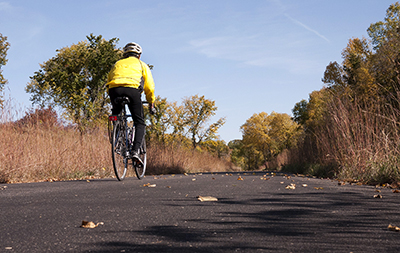By Joseph Palmersheim

The Central Lakes Bike Trail near Alexandria is part of the new U.S. Bike Route 20. The 188-mile bike route connects St. Cloud to Moorhead. U.S. Bicycle Routes do not build new bicycle infrastructure as part of the designation process. Instead, these routes combine existing roads and shared-use paths to create routes that connect some of Minnesota’s most beloved places. Photo by Paul Stafford |
A new 188-mile bike route connecting St. Cloud to Moorhead gives people in Minnesota more opportunity to take a trip by pedal power.
U.S. Bicycle Route 20, MnDOT’s newest nationally designated bike route (and the third in the state), connects Moorhead, west-central and central Minnesota to St. Cloud and the Mississippi River Trail (U.S. Bicycle Route 45). Traveling through scenic Minnesota prairies and past dozens of the state’s 10,000 lakes, the route invites riders to visit a series of small and historic towns parallel to I-94. It follows and links several state and regional trails, with more than two-thirds of the route on off-road paths.
But the route it still needs a name.
MnDOT turned to members of the public to help select one. Voters could choose from several options on an electronic form. These names, which highlight geographic features along the bike route, were suggested by participants attending a MnDOT event last year:
- Glacial Lakes Bicycle Route
- Prairie Lakes Bicycle Route
- MiddleSota Bicycle Route
- Rivers to Prairies Bicycle Route
- Towns and Fields Bicycle Route
Voting closed July 12. The winning name will be announced later this summer.
Work on developing Route 20 began in 2020, when the Office of Transit and Active Transportation went through a process to identify and select the next route for designation. The Route 20 corridor scored highly on health, economic, environmental and equity need metrics. It also offered an opportunity to leverage the significant investments already made in the Lake Wobegon and Central Lakes Trails.
The U.S. Bicycle Route System is a network of numbered cross-country routes. Currently there are more than 18,000 miles of U.S. Bicycle Routes in 31 states.
U.S. Bicycle Routes combine existing roads and shared-use paths to create routes that connect some of Minnesota’s most beloved places. MnDOT aims for these routes to be easy to follow, scenic in nature and on the safest available existing roads and paths. MnDOT's preference is to locate routes on paths separate from car and truck traffic. If that’s not possible, the second choice is road facilities with bicycle lanes or wide shoulders.
“Using existing infrastructure for U.S. Bicycle Routes makes the costs relatively small in comparison to building new facilities,” said Jake Rueter, active transportation coordinator. “MnDOT is currently working with a contractor not only on Route 20, but also on revisions to U.S. Bicycle Routes 41 (North Star Route) and 45 (Mississippi River Trail). The total cost of these contracted services is less than $250,000.”
MnDOT aims for these routes to be easy to follow, scenic in nature and on the safest available existing roads and paths. MnDOT's first choice is to locate routes on paths separate from car and truck traffic. If not available, road facilities with bicycle lanes or wide shoulders are preferred.
The agency had help with figuring out some of the better ways to do this. User feedback garnered during the public engagement process primarily focused on the condition of potential road and trail facilities, and destinations that would be desirable for people traveling along the route.
“We are extremely grateful to people who shared their local expertise, whether highlighting an area where road conditions make bicycling difficult, or a local destination that may help attract people to stop in communities,” Rueter said. “Minnesota has long been seen as a leader when it comes to making places for people to bike no matter their skill level or desired trip type. Designating additional U.S. Bicycle Routes continues to demonstrate this commitment, brings economic benefits to communities through bicycle tourism, and highlights the distinct natural beauty of our state.”
Learn more about U.S. Bike Route 20 and other Minnesota bike routes on MnDOT’s bicycling webpage. | 


